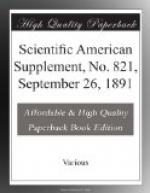Dextrins containing much starch are less hygroscopic than those which are nearly free from it, as the same conditions which promote the complete conversion of the starch into dextrin also favor the production of sugars, and it is to these sugars probably that commercial dextrin owes its hygroscopic nature. We have been in part able to confirm these results by a series of tests of the same gums in India, but have not yet obtained information as to their behavior in the early part of the year.
The fermentation of natural gum solutions is accompanied by a decrease in the viscosity of the liquid and the separation of a portion of the gum in lumps. Apparently those gums which contain most sugar, as indicated by their reduction of Fehling’s solution, are the most susceptible to this change. Oxalic acid is formed by the fermentation, which by combination with the lime present renders the fermenting liquid turbid, and also some volatile acid, probably acetic.
We have made some experiments with a gum which readily fermented—in a week—as to the respective value of various antiseptics in retarding the fermentation. Portions of the gum solutions were mixed with small quantities of menthol, thymol, salol, and saccharin in alkaline solution, also with boric acid, sodium phosphate, and potash alum in aqueous solution. Within a week a growth appeared in a portion to which no antiseptic had been added; the others remained clear. After over five months the solutions were again examined, when the following results were observed:
----------------------+--------------------------------
----------- | Antiseptics. | Solution after Five Months. ----------------------+-------------------------------------
------ | Menthol in KOH..... | Some growth at bottom, upper layer clear. | Thymol in KOH..... | Growth at top, gum white and opaque. | Salol in KOH........ | Growth at top, gum black and opaque | Saccharin in KOH ... | White growth at top. | Boric acid............| Remained clear; did not smell. | Sodium phosphate ... | Slight growth at top. | Potash alum......... | Slight growth at top. ----------------------+-------------------------------------
------
The solution to which no antiseptic had been added was of course quite putrid, and gave the reactions for acetic acid.
In the earlier part of this paper we have given a short account of the chief characteristics of the more important gum substitutes. The following additional notes may be of interest.




